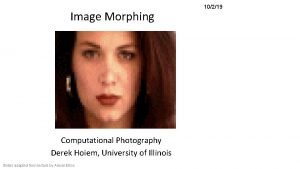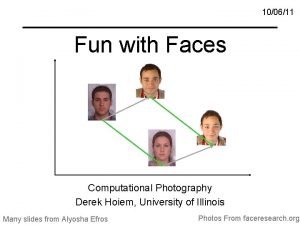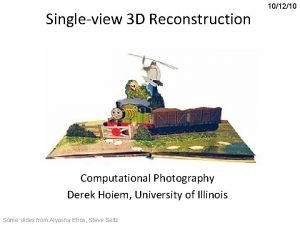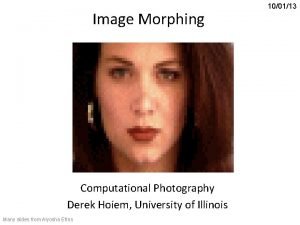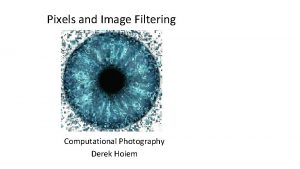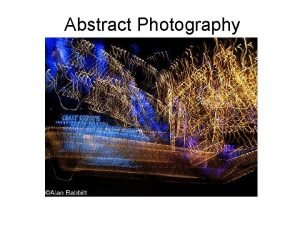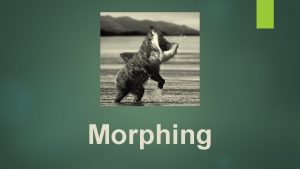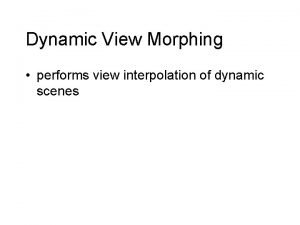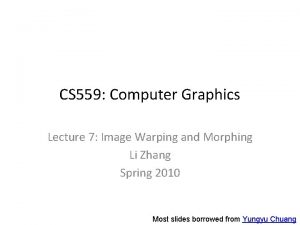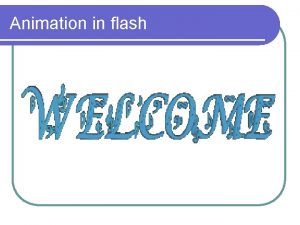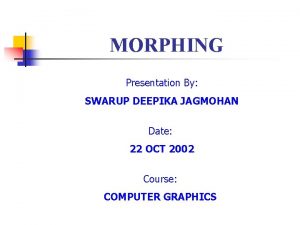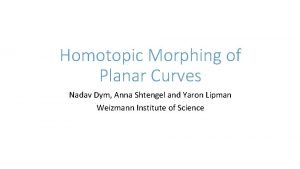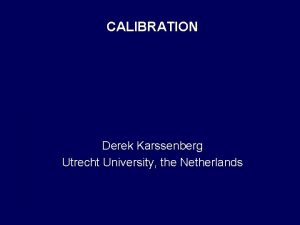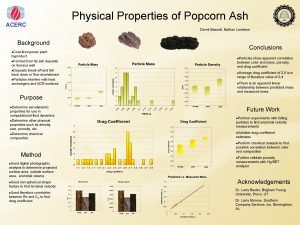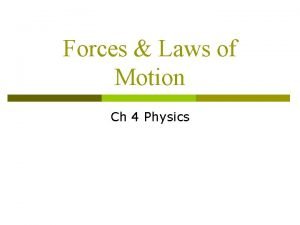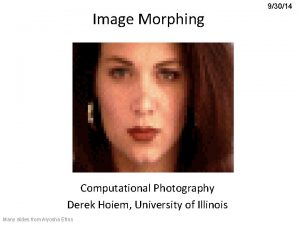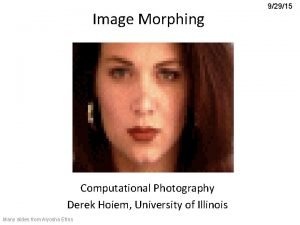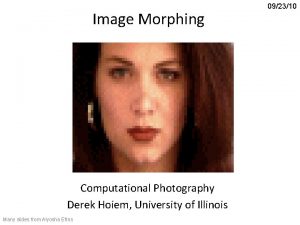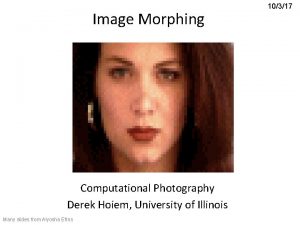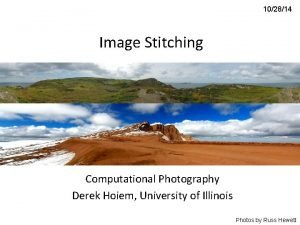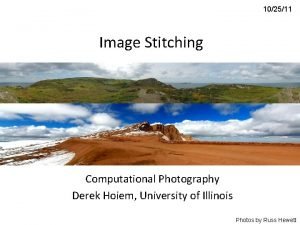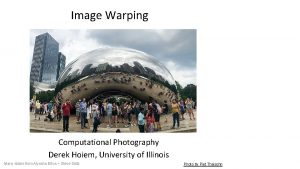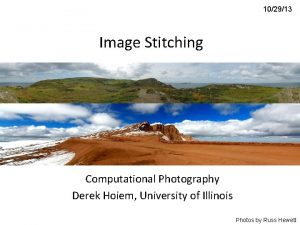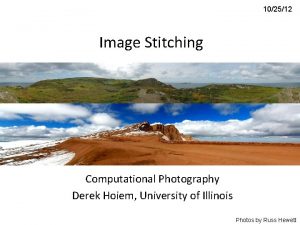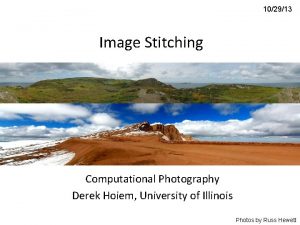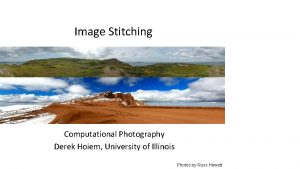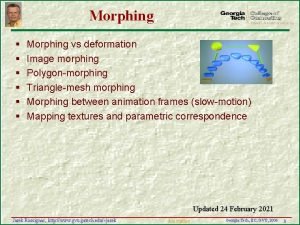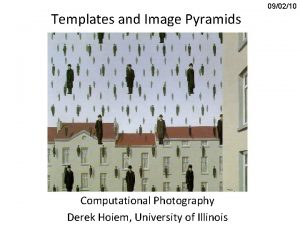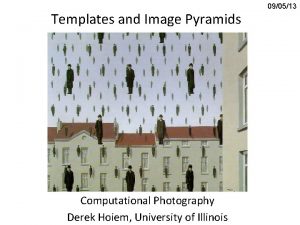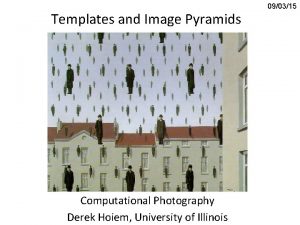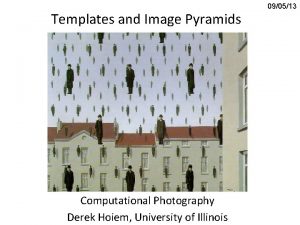Image Morphing Computational Photography Derek Hoiem University of


































- Slides: 34

Image Morphing Computational Photography Derek Hoiem, University of Illinois Many slides from Alyosha Efros

2 D image transformations These transformations are a nested set of groups • Closed under composition and inverse is a member

Take-home Question Suppose we have two triangles: ABC and A’B’C’. What transformation will map A to A’, B to B’, and C to C’? How can we get the parameters? B’ B ? T(x, y) A Source C C’ A’ Destination

Today: Morphing Women in art http: //youtube. com/watch? v=n. UDIo. N-_Hxs Aging http: //www. youtube. com/watch? v=L 0 GKp-uvj. O 0

Texturing in transformed coordinates T(x, y) y’ y x f(x, y) x’ g(x’, y’) Given a coordinate transform (x’, y’) = T(x, y) and a source image f(x, y), how do we compute a transformed image g(x’, y’) = f(T(x, y))?

Forward mapping T(x, y) y’ y x f(x, y) x’ g(x’, y’) Send each pixel f(x, y) to its corresponding location (x’, y’) = T(x, y) in the second image

Forward mapping What is the problem with this approach? T(x, y) y’ y x f(x, y) x’ g(x’, y’) Send each pixel f(x, y) to its corresponding location (x’, y’) = T(x, y) in the second image Q: what if pixel lands “between” two pixels? A: distribute color among neighboring pixels (x’, y’) – Known as “splatting”

Inverse mapping T-1(x, y) y’ y x f(x, y) x’ g(x’, y’) Get each pixel g(x’, y’) from its corresponding location (x, y) = T-1(x’, y’) in the first image Q: what if pixel comes from “between” two pixels?

Inverse mapping T-1(x, y) y’ y x f(x, y) x’ g(x’, y’) Get each pixel g(x’, y’) from its corresponding location (x, y) = T-1(x’, y’) in the first image Q: what if pixel comes from “between” two pixels? A: Interpolate color value from neighbors – nearest neighbor, bilinear, Gaussian, bicubic – E. g. interpolate. interp 2 or ndimage. map_coordinates in Python scipy

Bilinear Interpolation http: //en. wikipedia. org/wiki/Bilinear_interpolation

Forward vs. inverse mapping Q: which is better? A: Usually inverse—eliminates holes • however, it requires an invertible warp function

Morphing = Object Averaging The aim is to find “an average” between two objects • Not an average of two images of objects… • …but an image of the average object! • How can we make a smooth transition in time? – Do a “weighted average” over time t

Averaging Points Q What’s the average of P and Q? v=Q-P P Linear Interpolation New point: P + t*(Q-P) Or equivalently: (1 -t)P + t. Q 0<t<1 P + 0. 5 v = P + 0. 5(Q – P) = 0. 5 P + 0. 5 Q Extrapolation: t<0 or t>1 P + 1. 5 v = P + 1. 5(Q – P) = -0. 5 P + 1. 5 Q (t=1. 5) P and Q can be anything: • points on a plane (2 D) or in space (3 D) • Colors in RGB (3 D) • Whole images (m-by-n D)… etc.

Idea #1: Cross-Dissolve Interpolate whole images: Imagehalfway = (1 -t)*Image 1 + t*image 2 This is called cross-dissolve in film industry But what if the images are not aligned?

Idea #2: Align, then cross-disolve Align first, then cross-dissolve • Alignment using global warp – picture still valid Image credit: Efros

Dog Averaging What to do? • Cross-dissolve doesn’t work • Global alignment doesn’t work – Cannot be done with a global transformation (e. g. affine) • Any ideas? Feature matching! • Nose to nose, tail to tail, etc. • This is a local (non-parametric) warp

Idea #3: Local warp, then cross-dissolve Morphing procedure For every frame t, 1. Find the average shape (the “mean dog” ) • local warping 2. Find the average color • Cross-dissolve the warped images

Local (non-parametric) Image Warping Need to specify a more detailed warp function • Global warps were functions of a few (2, 4, 8) parameters • Non-parametric warps u(x, y) and v(x, y) can be defined independently for every single location x, y! • Once we know vector field u, v we can easily warp each pixel (use backward warping with interpolation)

Image Warping – non-parametric Move control points to specify a spline warp Spline produces a smooth vector field

Warp specification - dense How can we specify the warp? Specify corresponding spline control points • interpolate to a complete warping function But we want to specify only a few points, not a grid

Warp specification - sparse How can we specify the warp? Specify corresponding points • • interpolate to a complete warping function How do we do it? How do we go from feature points to pixels?

Triangular Mesh 1. Input correspondences at key feature points 2. Define a triangular mesh over the points • • Same mesh (triangulation) in both images! Now we have triangle-to-triangle correspondences 3. Warp each triangle separately from source to destination • Affine warp with three corresponding points (just like takehome question)

Triangulations A triangulation of set of points in the plane is a partition of the convex hull to triangles whose vertices are the points, and do not contain other points. There an exponential number of triangulations of a point set.

An O(n 3) Triangulation Algorithm Repeat until impossible: • Select two sites. • If the edge connecting them does not intersect previous edges, keep it.

“Quality” Triangulations Let (Ti) = ( i 1, i 2 , . . , i 3) be the vector of angles in the triangulation T in increasing order: • A triangulation T 1 is “better” than T 2 if the smallest angle of T 1 is larger than the smallest angle of T 2 • Delaunay triangulation is the “best” (maximizes the smallest angles) good bad

Improving a Triangulation In any convex quadrangle, an edge flip is possible. If this flip improves the triangulation locally, it also improves the global triangulation. If an edge flip improves the triangulation, the first edge is called “illegal”.

Naïve Delaunay Algorithm Start with an arbitrary triangulation. Flip any illegal edge until no more exist. Could take a long time to terminate.

Delaunay Triangulation by Duality Draw the dual to the Voronoi diagram by connecting each two neighboring sites in the Voronoi diagram. • The DT may be constructed in O(nlogn) time Demos: http: //www. cs. cornell. edu/home/chew/Delaunay. html http: //alexbeutel. com/webgl/voronoi. html

Image Morphing How do we create a morphing sequence? 1. Create an intermediate shape (by interpolation) 2. Warp both images towards it 3. Cross-dissolve the colors in the newly warped images

Warp interpolation How do we create an intermediate shape at time t? • Assume t = [0, 1] • Simple linear interpolation of each feature pair – (1 -t)*p 1+t*p 0 for corresponding features p 0 and p 1

Morphing & matting Extract foreground first to avoid artifacts in the background Slide by Durand Freeman

Dynamic Scene Black or White (MJ): http: //www. youtube. com/watch? v=R 4 k. LKv 5 gtxc Willow morph: http: //www. youtube. com/watch? v=u. LUyu. Wo 3 p. G 0

Summary of morphing 1. Define corresponding points 2. Define triangulation on points – Use same triangulation for both images 3. For each t = 0: step: 1 a. Compute the average shape (weighted average of points) b. For each triangle in the average shape • • Get the affine projection to the corresponding triangles in each image For each pixel in the triangle, find the corresponding points in each image and set value to weighted average (optionally use interpolation) c. Save the image as the next frame of the sequence

Next classes Pinhole camera: start of perspective geometry Single-view metrology: measure 3 D distances from an image
 Derek hoiem
Derek hoiem Derek hoiem
Derek hoiem Derek hoiem
Derek hoiem Morphing photography
Morphing photography Computational photography uiuc
Computational photography uiuc Computational photography uiuc
Computational photography uiuc Is abstract photography same as conceptual photography
Is abstract photography same as conceptual photography What is morphing
What is morphing View morphing
View morphing Photosh
Photosh Morphing and warping
Morphing and warping Morphing
Morphing Local warping
Local warping Morphing
Morphing Morphing in flash
Morphing in flash What is morphing
What is morphing Morphing
Morphing Nadav dym
Nadav dym Digital photography with flash and no-flash image pairs
Digital photography with flash and no-flash image pairs Codeopinion github
Codeopinion github Derek glaaser
Derek glaaser Derek england
Derek england Derek paiz
Derek paiz Grandfather by derek mahon poem analysis
Grandfather by derek mahon poem analysis Derek jeter childhood home
Derek jeter childhood home Derek alton walcott
Derek alton walcott Derek comartin
Derek comartin Hill climbing
Hill climbing Ma trận ie
Ma trận ie Barbara stringer
Barbara stringer Xiv derek walcott meaning
Xiv derek walcott meaning Physical properties of popcorn
Physical properties of popcorn Derek farnsworth
Derek farnsworth Derek donahue
Derek donahue Sum of forces equation
Sum of forces equation
